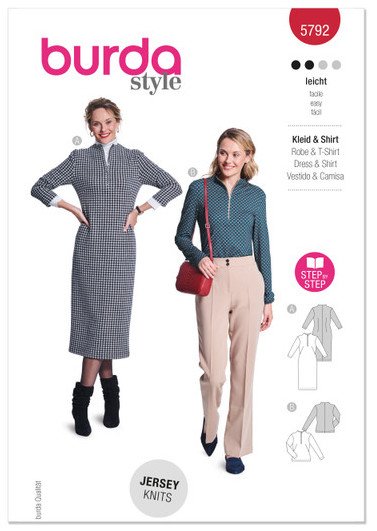Form Not Following Function
Just before I started working on the Kanoko Tote, I took a chunk of lighter-weight ponte out of the stash. It was sitting on the table next to the Simplicity 9328 pattern, which gave me the idea to use it for a wearable muslin. The ponte was a Walmart remnant that was something like $8 for four yards, and interlock knits were one of the fabrics specified on the pattern envelope.
[Our Walmart has been very thin on remnants for some reason. Either I am not getting there on days it has been restocked, or they stopped ordering for it. Oh, well. At least I am not being tempted to add to the stash.]
Simplicity 9328 is a quarter-zip top/dress pattern:
In keeping with my habit of making the pattern as written, the only changes I made were to adjust the position of the bust darts slightly. I don’t think I even lengthened this one as it looked good next to my bodice sloper.
And because I haven’t yet been punished enough by zippers, of course I chose another pattern with a zipper insertion—into a knit fabric, no less. I followed the directions to the letter. Next time I won’t. The zipper went in easily, all things considered. I used my dual-feed zipper foot, which kept the stripes from going wonky around the zipper placket. For some reason—more on this in a moment—the pattern instructs you to sew a length of grosgrain ribbon over the zipper edges on the wrong side after the zipper is inserted. I see no reason to do that in future iterations. All that accomplished was to add bulk to the neckline area which became a problem when attaching the collar. Looking at the reviews for this pattern on the Sewing Pattern Review website, I see that other people came to the same conclusion.
And that collar . . . sigh. I want to make this again, but I am going to do the collar differently. The instructions had me sew the interfaced collar facing onto the body, leaving 5/8" of the collar extending past the edge of the body. Then I had to sew the collar onto the collar facing. The bottom edge of the collar was folded in and pressed by 5/8". After the collar was sewn onto the collar facing, it was turned inside out and that folded edge stitched down to cover the raw seams.
Here’s today’s sermon for you: A long time ago, when sergers were less common and more expensive, many sewists made their knit garments using sewing machines. (Hello, Stretch & Sew.) However, it is now 2025, not 1986. A decent-quality serger can be had these days for a couple hundred dollars, and if you’re like me and scour thrift stores, you might even pick up a BabyLock serger for $13.99. However, most sewing patterns are still being written as though sergers don’t exist. This pattern could have been improved dramatically by the addition of a few notes about where a serger would be a better choice than a sewing machine for some techniques. In addition, this pattern read as though it had been written for a woven garment. The sleeve instructions were similar to those for a woven garment, even though it is far easier and quicker to sew sleeves in flat on knit garments. And I am not entirely convinced that this design needs bust darts.
This is what ended up happening at that collar area: There was so much bulk at that front corner—thanks to the redundant grosgrain ribbon, the zipper tape, and four layers of (graded) collar seams—that nothing would lie nicely. I finally ran the seam that attached the collar facing to the body through the serger, which flattened and neatened that seam enough that I was able to topstitch down the collar. I am not happy with the collar, though. Next time, I am going to assemble the collar separately (on the serger) and attach it to the body with the serger, foregoing the instructions to fold up that bottom collar edge and sew it down to cover the raw edge. That means I will have a serger edge there, yes, but I think the entire collar will look better. If I were so inclined, I could sew knit binding over the serger seam to cover it. I looked at a few other quarter-zip tops in my wardrobe and that is how they are constructed.
The striped fabric probably wasn’t the best choice. The bust darts look a little weird when the dress is on me, even though they are perfectly positioned and sewn. I should have done the collar in a solid color. And I ended up cutting the sleeves too short (don’t ask), so I had to add cuffs to make them the correct length. Solid-color cuffs would have tied in nicely with a solid-color collar.
It’s done. I learned a lot. I would make this again but with some changes. I’ve also got this Burda pattern:
This pattern is collarless and has French darts. I am going to read through those instructions today to see how they treat that zipper insertion.
I keep telling myself that none of this is a waste of time, even if I end up with something less than perfect. It’s all a learning process. This is why sewists make muslins.
I am not sure what will be up next on the cutting table. I might take a day or two away from sewing and allow the recent makes to percolate through my brain.


